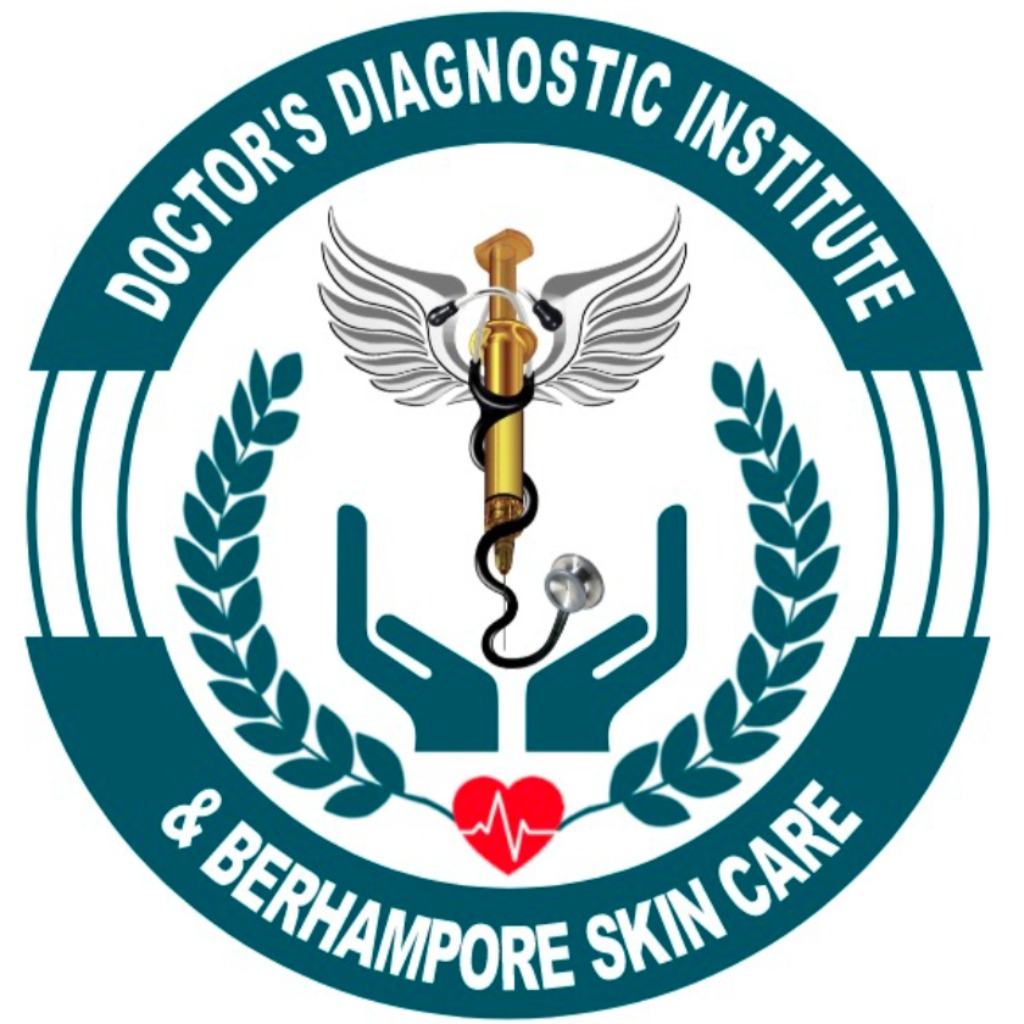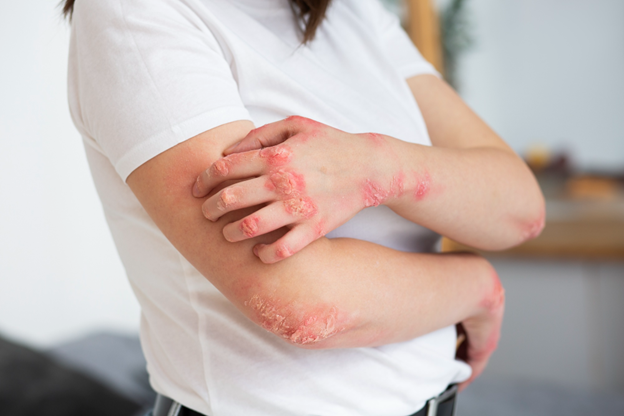What is Psoriasis?
Psoriasis is a chronic autoimmune condition that primarily affects the skin. It is characterized by the rapid growth of skin cells, leading to the formation of thick, scaly patches on the skin’s surface. These patches can vary in appearance, from red, inflamed areas with silver scales to silvery, flaky plaques. Psoriasis is not contagious, but it can significantly impact a person’s physical and emotional health.
The condition can appear anywhere on the body, but it is most commonly found on the elbows, knees, scalp, and lower back. The severity of psoriasis can range from mild, with a few patches, to severe, where large areas of skin are affected. Psoriasis often goes through periods of flare-ups and remissions, making it a challenging condition to manage.
What Causes Psoriasis?
Psoriasis occurs when the immune system mistakenly attacks healthy skin cells. The immune system typically protects the body from harmful invaders, such as bacteria and viruses. However, in individuals with psoriasis, the immune system becomes overactive, causing inflammation and triggering the rapid production of new skin cells.
Normally, skin cells are created in the lower layers of the skin and gradually move upward to replace old, dead cells. This process usually takes around 28 to 30 days. In people with psoriasis, skin cells are produced too quickly—sometimes in just a few days—and they accumulate on the skin’s surface, forming thick, silvery scales.
There are several factors that may contribute to the development of psoriasis:
- Genetics: If you have a family history of psoriasis, you are more likely to develop the condition.
- Immune System Dysfunction: Psoriasis is an autoimmune disorder, meaning the body’s immune system attacks its own tissues.
- Environmental Triggers: Stress, infections (like strep throat), cold weather, certain medications, and skin injuries can trigger or worsen psoriasis flare-ups.
Types of Psoriasis
There are different types of psoriasis, each with its own symptoms and treatment options. The most common types include:
- Plaque Psoriasis: This is the most common form, accounting for about 80% of cases. It presents as raised, red patches covered with silver-white scales. These plaques often appear on the elbows, knees, and scalp.
- Guttate Psoriasis: Guttate psoriasis typically appears as small, drop-shaped red patches on the skin. It is often triggered by infections like strep throat and is more common in children and young adults.
- Inverse Psoriasis: This type affects areas with folds of skin, such as the armpits, groin, and under the breasts. The affected skin appears smooth, red, and shiny, without scales.
- Pustular Psoriasis: Pustular psoriasis is characterized by white pustules (blisters of noninfectious pus) surrounded by red skin. It can appear anywhere on the body, but it is most commonly seen on the hands and feet.
- Erythrodermic Psoriasis: This is a rare but severe form of psoriasis that can cover large areas of the body with red, peeling skin. It is often associated with severe itching and pain and requires immediate medical attention.
Symptoms of Psoriasis
The symptoms of psoriasis can vary from person to person, depending on the type and severity of the condition. Common symptoms include:
- Red, inflamed skin: Psoriasis often causes areas of the skin to become red and inflamed.
- Scaly patches: These patches are usually covered with silvery-white scales and may crack or bleed.
- Itching or burning: Psoriasis can be very itchy, leading to discomfort and irritation.
- Dry, cracked skin: The skin may become dry and cracked, sometimes leading to bleeding.
- Thickened or ridged nails: In some cases, psoriasis affects the nails, causing them to become pitted or discolored.
- Swollen joints: Psoriatic arthritis can cause inflammation and swelling in the joints, leading to pain and stiffness.
Diagnosis of Psoriasis
A dermatologist typically diagnoses psoriasis through a physical examination. During the exam, the doctor will assess the skin for the characteristic appearance of psoriasis patches. If the diagnosis is unclear, the doctor may take a small sample of the affected skin (skin biopsy) to confirm the diagnosis and rule out other conditions.
In some cases, the doctor may ask about the patient’s family history and any environmental factors that may have triggered the condition, such as recent infections, stress, or skin injuries.
Treatment Options for Psoriasis
While there is no cure for psoriasis, there are many effective treatments that can help control the symptoms and prevent flare-ups. Treatment options vary depending on the severity of the condition and may include:
1. Topical Treatments
Topical treatments are often the first line of defense for people with mild to moderate psoriasis. These include:
- Corticosteroids: Topical corticosteroids are the most common treatment for reducing inflammation and controlling flare-ups. They help reduce redness, swelling, and itching.
- Vitamin D analogs: These creams and ointments help slow down the growth of skin cells and are often used in combination with corticosteroids.
- Coal tar: Coal tar products can help reduce scaling, itching, and inflammation, although they may be messy to use.
- Topical retinoids: These products help normalize skin cell turnover and reduce the thickening of skin.
- Calcineurin inhibitors: These are nonsteroidal medications that can help reduce inflammation and itching.
2. Phototherapy (Light Therapy)
Phototherapy uses ultraviolet (UV) light to treat psoriasis. UV light slows down the rapid production of skin cells and reduces inflammation. Phototherapy can be done at a dermatologist’s office or at home with special equipment, depending on the type of UV light used. It is typically recommended for moderate to severe psoriasis.
3. Systemic Treatments
For more severe cases of psoriasis, systemic treatments may be necessary. These medications work throughout the body and may include:
- Oral medications: Drugs like methotrexate, acitretin, and cyclosporine can help control psoriasis by suppressing the immune system or slowing skin cell production.
- Biologic therapies: Biologics are a newer class of medications that target specific parts of the immune system responsible for psoriasis. They are often used for severe psoriasis that does not respond to other treatments.
4. Lifestyle Modifications
In addition to medical treatments, certain lifestyle changes can help manage psoriasis:
- Moisturizing: Keeping the skin moisturized helps prevent dryness and cracking, reducing the risk of flare-ups.
- Stress management: Since stress is a known trigger for psoriasis, practicing relaxation techniques such as meditation, yoga, and deep breathing exercises may help reduce flare-ups.
- Dietary changes: Some people find that certain foods can trigger psoriasis, while others may benefit from an anti-inflammatory diet rich in omega-3 fatty acids, fruits, and vegetables.
- Avoiding triggers: Identifying and avoiding psoriasis triggers, such as infections or smoking, can help prevent flare-ups.
Living with Psoriasis
Although psoriasis is a chronic condition, it can be managed effectively with the right treatment plan. It is important to work closely with a healthcare provider to find the most suitable treatment for your condition. Regular check-ups are essential to ensure that treatments are working and to make adjustments as necessary.
Living with psoriasis can be emotionally challenging, but with proper management, individuals can lead fulfilling lives. Support groups and counseling may also help those dealing with the emotional and psychological impact of psoriasis.
Conclusion
Psoriasis is a complex, chronic condition that affects many aspects of life. However, with the right treatments and lifestyle changes, individuals with psoriasis can significantly improve their quality of life. By working closely with a healthcare provider and staying informed about the condition, you can better manage symptoms and prevent flare-ups.
Consult us today at Doctor’s Diagnostic for expert guidance!

